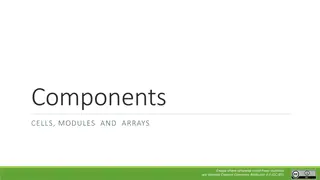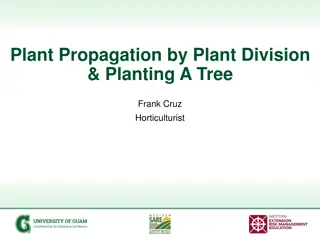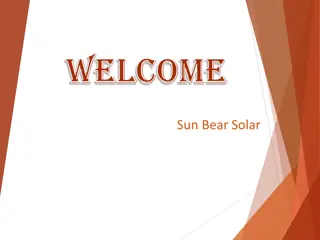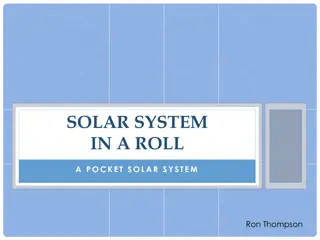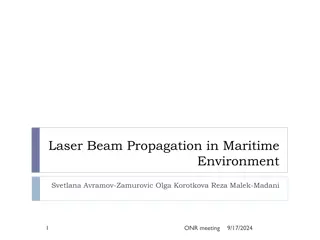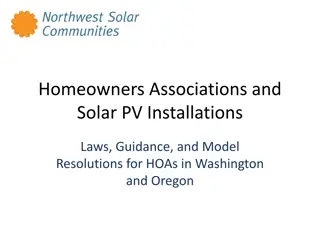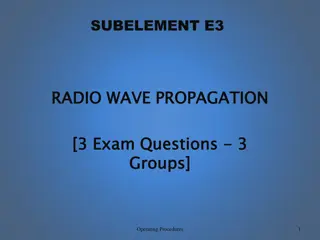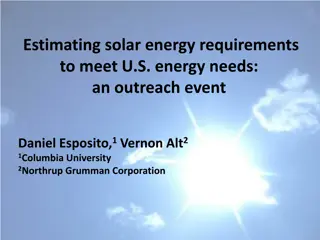Understanding HF Propagation and Solar Activity
Explore the basics of HF propagation, how solar activity influences band conditions, and the impact of phenomena like sunspots, flares, and CMEs. Learn which bands to use for effective communication and grasp the fundamentals of wave propagation, refraction, and reflection. This presentation provides a high-level overview in simple terms for quick understanding.
Download Presentation

Please find below an Image/Link to download the presentation.
The content on the website is provided AS IS for your information and personal use only. It may not be sold, licensed, or shared on other websites without obtaining consent from the author. Download presentation by click this link. If you encounter any issues during the download, it is possible that the publisher has removed the file from their server.
E N D
Presentation Transcript
The Sun and HF Propagation Lu Romero W4LT 1/2018
Here is what we are going to discuss: Basic HF Propagation principles How solar activity influences band conditions Sunspots, Flares and CME s (Oh My!) Which band should I use to reach an area?
And a Quick Disclaimer: People spend lifetimes studying this stuff! I have less than an hour to explain the basics to you. This presentation will be a 50 thousand foot view of the subject.
Basics of Wave Propagation: There are two basic ways Groundwave Skywave
Propagation Basics: The Sun influences all communication modes beyond Ground Wave or line of sight. HF Conditions will vary with time of day, season and location on the face of the earth. All wave reflection happens at any boundary between two materials with different properties. Radio waves can be reflected by any and all physical objects they encounter. Some energy is ALWAYS lost as a radio wave propagates through any medium.
Propagation Basics: REFRACTION (Not Reflection) is what causes a wave to bend in the ionosphere. REFLECTION is what causes a wave to bounce off objects in the Physical World Waves bend because they enter and exit the medium at different speeds. The higher the frequency, the more the wave bends. Reflection causes multipath additive and subtractive effects (fading) mostly on ground and line of sight waves
Propagation Basics: Depending on the frequency and power
Propagation Basics: Traversing every boundary takes its toll
Solar Radiation and Propagation: Affects the physical properties of the ionospheric layers Influences refraction of frequencies below 30-50MHz Ionization (amount of free electrons and ions) depends on Ultraviolet and X-Ray radiation from the sun Skip distances are influenced by fequency, ionization levels (ion density) and ionospheric layer height, along with angle of radiation of the skywave Higher ionization refracts more dense wave fronts Wave front density influences received signal strength
Solar Radiation and Propagation: Solar Radiation is not constant, and varies:
Solar Indices that count: Solar Flux (SFU) Smoothed Sunspot Number (SSN) X-Ray Flux Geomagnetic Activity
Solar Indices Solar Flux (SFU) Amount of Solar Noise at 2.8GHz (10.7 cm band) The level of ionization in the F2 layer = Good approximation of HF wave refraction coefficient. SFU will run from a low of around 50 to a high of around 300 units. Low numbers reflect low Maximum Useable Frequencies; High numbers indicate good ionization Higher the SFU Better HF conditions
Solar Indices Sunspot Number (SSN): SSN reflects the level of sunspot activity Is calculated using a 6 month sliding record(6 months before and adjusted data for the current activity) Varies from 0 to 200 with an average of around 100 at its maximum High SSN means great HF propagation and not so good LF propagation Low SSN means not so good HF propagation and great LF propagation High band ops like High SSN Low band ops are the opposite
Solar Radiation and Propagation: Current Solar Cycle:
Solar Indices X-ray Flux Impacts the amount of absorption in the ionosphere Defines how Solar Flares impact HF propagation on the SUNLIT side of the planet Is a measure of the strengths of solar flares. Takes 8 minutes to affect the earth (relativistic speeds) Indexed via letter indications High Flux = Radio Blackouts due to absoption usually in the D-Layer
Solar Indices X-ray Flux Solar X-ray flux (flare strength) Level Flux (watts/sq meter) Description A less than 10-8 Very Low Background A between 10-8 and 10-7 Low Background B between 10-7 and 10-6 Moderate Background High Background/Low Flare C between 10-6 and 10-5 M between 10-5 and 10-4 Moderate Flare X between 10-4 and 10-3 High Flare Y greater than 10-3 Extreme Flare
Solar Indices X-ray Flux Solar X-ray flux (flare strength)
Solar Indices Geomagnetic Storms Different from Radio Flux Associated with Coronal Mass Ejections Variable speed Particulates Not relativistic Influences Magnetic Field of earth Associated with Aurora events
Solar Indices Geomagnetic Storms Coronal Mass Ejections Lots of atomic particles like free protons and alpha particles (ions, stripped atoms) cause absorption to be increased especially in the polar regions (Auroral Absorption) Magnetic Field disturbances enhance Sporadic E propagation especially from 28 to 144MHz (especially 50MHz) Impart a rough or watery sound to HF signals, especially those that have to traverse the Auroral Oval at higher angles.
Solar Indices Geomagnetic Storms Variations in the earth s magnetic field are classified as QUIET, UNSETTLED, ACTIVE and STORM The K index: A number over a 3 hour range of magnetic activity. Range is 0 to 9 Lower is better conditions The A index: A number standing for the daily average of K index values Range is 0 to 100 Lower is better Remember, what is good for high band HF (20m and up) is inversely proportional for low band HF (30m and below). Usually, bad high band = good low band condx
Conclusions and Theories Propagation predictions are both Art and Science They are PREDICTIONS. Conditions change dynamically When the band is capable of propagation and no one is using it, is it really dead? New digital modes are revealing that dead bands are not really dead! The amount of variables in this subject is immense! Practice makes perfect Get on the radio and see what you can work!
Conclusions and Theories 160 (and below) Generally night time winter bands best under low SSN conditions for DX Generally: 80 and 40 meters are good bands for communication Short distance during the day Long distance at night. Less QRN in winter (fewer Thunderstorms) 30 meters allow greater distance communication at night than 40 meters
Conclusions and Theories 20 meters Bread and Butter band usually open intracontinentally during the day and intercontinentally in the morning and evening closes early in low sunspot times, stays open all night in higher sunspot times 15 meters Daytime band only during low sunspot times Great DX potential during high sunspot times 10 meters Great DX propagation with low power during high sunspot times usually daytime only during low sunspots 6 meters considered a VHF band, but acts like 10 in high SSN periods
More information on Propagation QRZ Solar Report www.qrz.com NOAA Space Resources www.sec.noaa.gov Solar Activity Report www.dxlc.com/solar Australian AF - www.sws.bom.gov.au/HF_Systems HFLink - www.hflink.com/propagation/ Absorption - www.swpc.noaa.gov/products/d-region- absorption-predictions-d-rap ARRL www.arrl.org
The Sun and HF Propagation Questions and Comments Lu Romero W4LT lromero56@tampabat.rr.com









